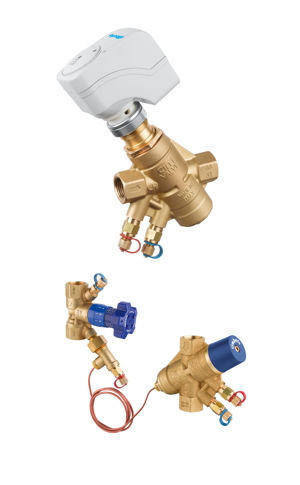Getting the best from self-regulating valves

Self-regulating valves have the potential to achieve cost-effective and optimised control in distribution networks. Paul Wightman of Albion Valves considers how to get the best from them.
Maintaining higher differentials between flow and return temperature in heating systems and low return temperatures is all about getting the most out of the energy that you put into a system with minimal effort and wastage.
First-class efficiency credentials across the board is the ultimate goal in the design of a high-performing, modern building-services network that is productive, low maintenance and cost-effective.
The specifier has a key role to play in the process of creating a scheme that delivers proficiently, and self-regulating valves should be top of the kit list as vital components in the smooth running of the system — as one wrong fitting can put the whole system off kilter.
Self-regulating valves open and close in direct response to changes in the physical environment of the valve. A pressure or differential-pressure regulator typically applies the pressure of the controlled process fluid against a diaphragm. This diaphragm then opposes a compressed spring to achieve force-balance with the diaphragm at a given set pressure.
Any change in the controlled pressure causes the diaphragm to move, which causes the flow area of the regulator to change, allowing more or less fluid through the regulator.
To get the best out of the regulators in any system, the designer should consider using a balanced flow-controlled system, to help ensure a correct supply of heating and cooling to all parts of the installation.
For optimal energy efficiency and comfort control, differential-pressure control valves should be used as close to the output terminals as possible. However, cost-effectiveness dictates these may be installed within network branches and sub-branches, in which case balancing and control valves may be used downstream to maintain seamless performance.
The introduction of pressure-independent control valves (PICVs) has successfully combined these functions to enable cost-effective optimised control within the distribution networks, although PICVs are not appropriate for every system.
Low supply and return temperatures in centralised plant rooms and distribution networks are important operational factors for obtaining an efficient district-heating system. To achieve low return temperatures, customer sub-stations and secondary heating systems must perform without temperature faults.
Low return-water temperature will consequently increase the capacity of the network to transport heat, maximising efficiency and ultimately limiting the carbon footprint. A similar concept can be applied to cooling networks.
If we take the example of a chilled-water system, every single component will affect the pressure of the system. If the chilled-water temperature range is not maintained, the plant will experience low ∆T, which would require plant operators to run extra pumps and chillers to meet demand. This in turn reduces the plant’s cooling output and wastes energy.

Similarly, in a retail environment where shop floors need bright lighting to run all day, the heat energy may be lost to create a second-grade heat waste which could be returned through a heat recovery ventilation system, which would be much more energy efficient.
The only real way to capture or use this heat energy efficiently is via variable-volume systems, which should be a consideration at initial design stages of a building services network. A benefit could be that under low loads and more normal operational load levels that renewable energy or low-carbon energy may be the only energy source required, increasing savings in energy consumption.
Self-regulating valves are, by definition, self-controlling and do not require any further input from the engineer once commissioned. This ensures the very best performance levels when set-up correctly.
For example, a DPCV (differential-pressure control valve) is a mechanical valve that is not influenced by any external control system; it will control the differential pressure as per the set-point on the valve.
This can also be called a dynamic balancing valve because it is adjusting to the system and maintaining its set-point position, so it is moving in response to the system.
Pressure-independent control valves (PICVs) are also self-regulating as they control dynamically to the system — much like a DPCV. They also have a control actuator on them that allows the control system to interact with them and adjust their output to the system’s need.
This is not unique to PICVs as any control valve has this actuator feature. However, getting the best out of a PICV relies on it doing the self-regulation — and combining several other functions at the same time. This improves its performance, in relation to the circulatory system, and therefore benefits system performance, energy efficiency and comfort.
Typically, the aim of any system is to get the balance just right and circulate the right amount of water needed to maintain performance and comfort. Too little flow means poor comfort, while too much flow also means poor comfort and results in wastage and inefficiency.
Paul Wightman is technical specifications manager with Albion Valves.







